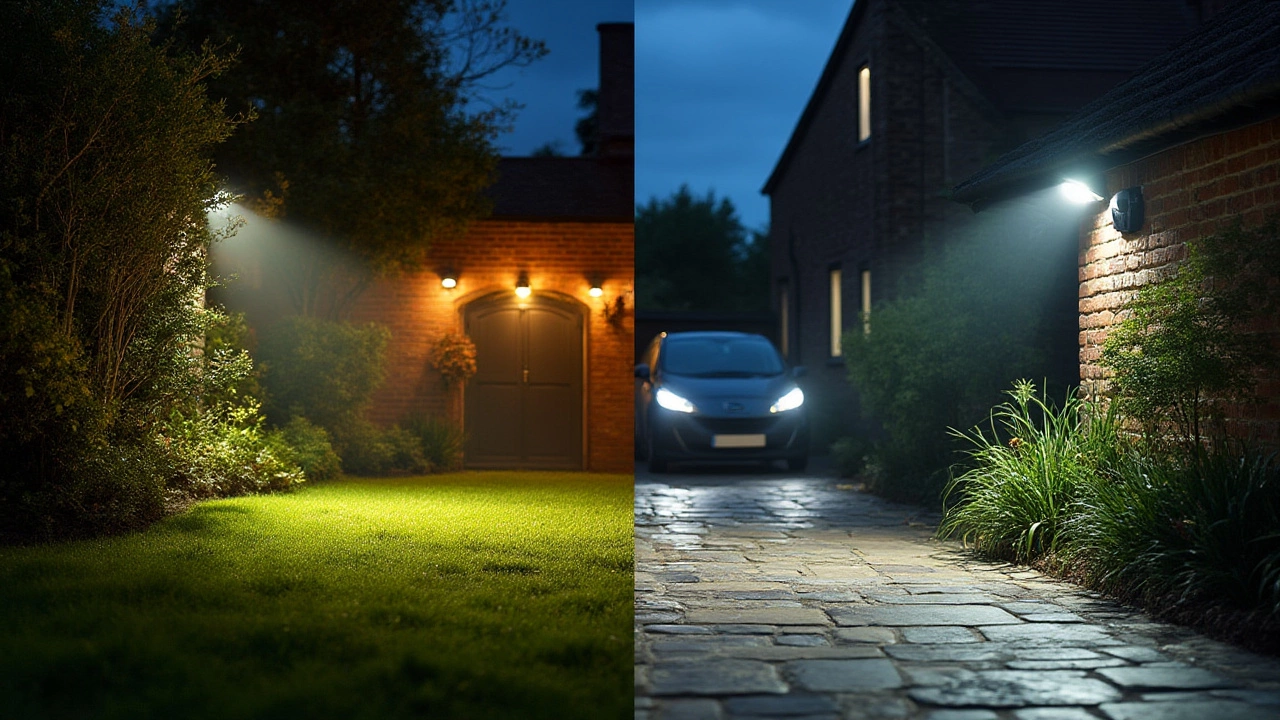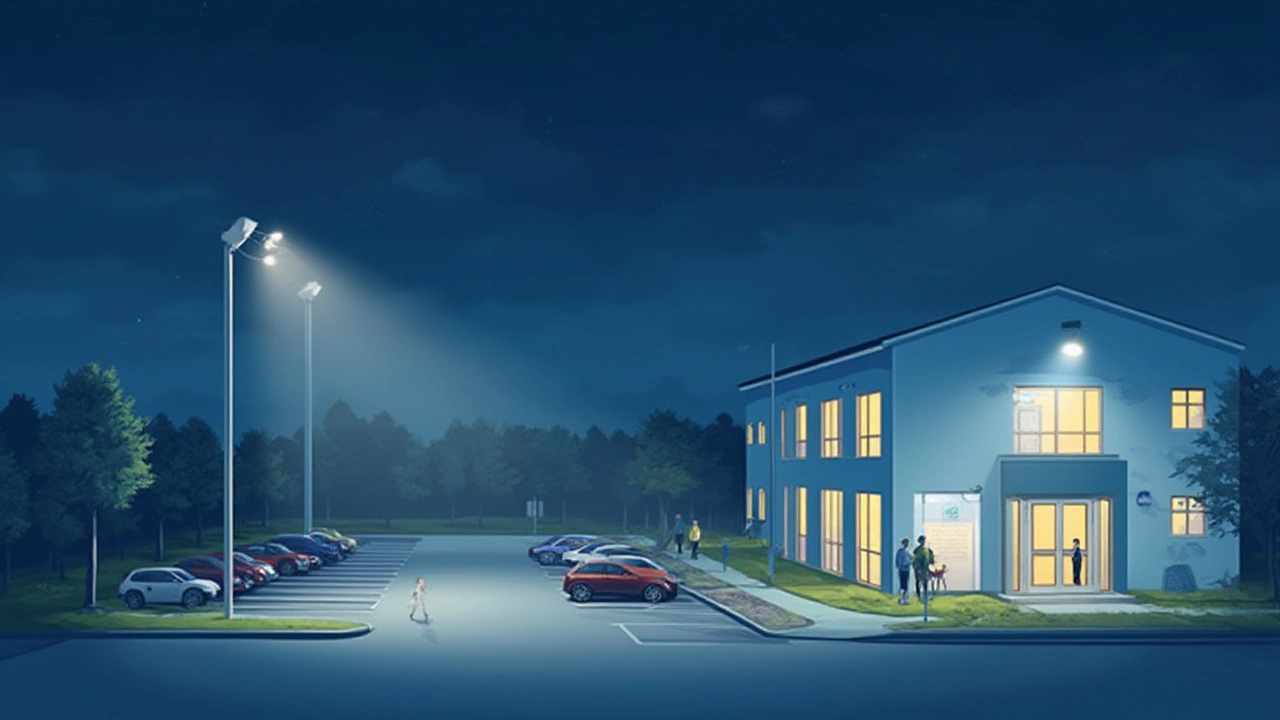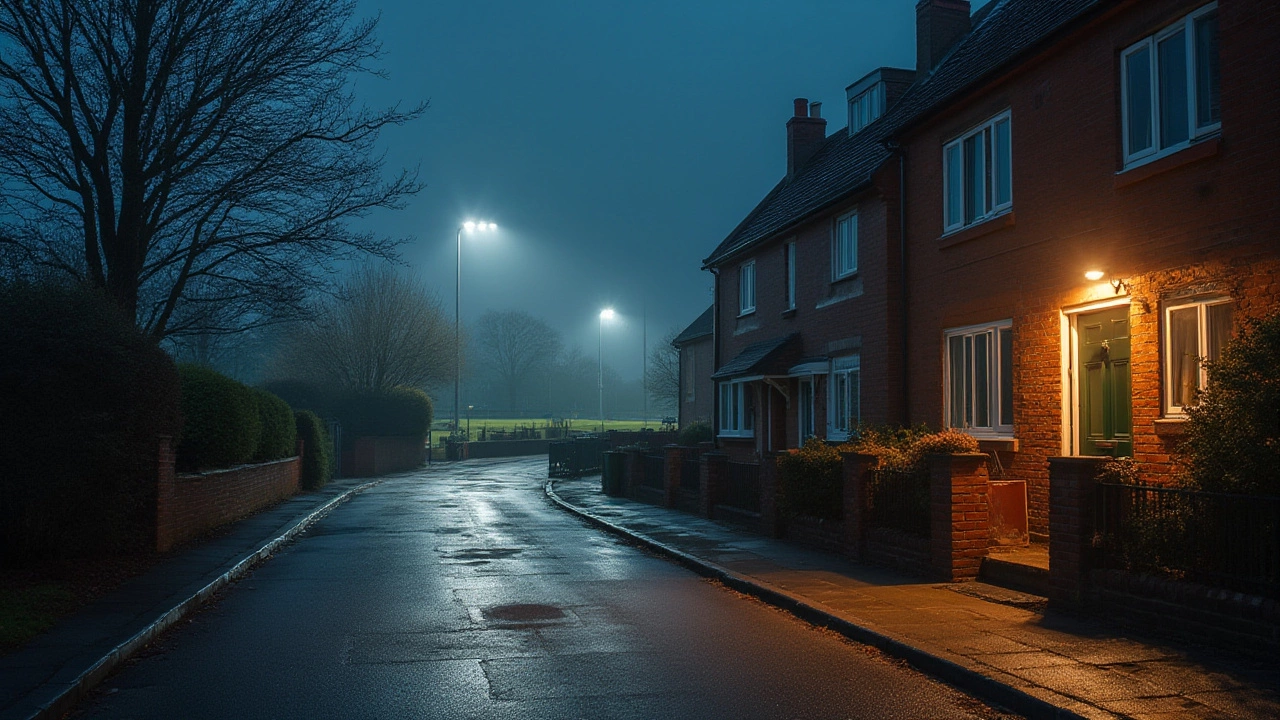Ever wandered around your yard at night and wondered whether that bright light by your garage is a floodlight or a security light—or if it even matters? This is more than a naming thing. The lighting you pick not only affects how well you see at night but could make a big difference in keeping your place safer. Homeowners spend an average of $250 per year on outdoor lighting upgrades, but a lot of folks don’t know if they’ve actually picked the right kind of light for their needs in the first place. Here’s where things get interesting: while people use the words ‘floodlight’ and ‘security light’ interchangeably, they don’t always mean the same thing. Stick around—it’s honestly kind of wild how much the type and setup of your outdoor lighting can change your sense of security and even lower insurance headaches.
Breaking Down Floodlights: What They Really Do
Floodlights are the workhorses of outdoor lighting. These things are all about sheer power. Think stadiums, parking lots, or big driveways. Floodlights are designed to cover a huge area, and they do this by shining a broad, intense beam—usually at a 120-degree angle or more. The goal? Flood the place with light, nothing left in the dark. That’s where the name comes from. It’s not about security features, it’s about brightness and coverage.
If you dig into the specs, the most common household floodlights use anywhere from 700 to over 20,000 lumens. Compare that to your old 60-watt indoor bulb (that’s only about 800 lumens), and you get the picture—these lights are designed to make the outdoors look like day. Outdoor LED floodlights have quickly replaced old halogen options, slashing energy bills by 60% or more, all while lasting 10 years or longer without burning out. That’s why many local soccer fields and warehouses made the switch to LEDs early—the math just works out.
Floodlights aren’t usually loaded with smart features. They’re often left on a timer, motion sensor, or controlled by a switch. Their simple job is to keep lawns, yards, and side alleys well lit. Homeowners often stick them above garages or roof eaves, angled down and away from windows to avoid blinding everyone inside. But here’s a tip: pointing them at fences or dark corners instead of shining them across open space makes them way more useful and less annoying to neighbors.
If you use floodlights around your house, their primary job is functional safety. You want a well-lit walkway or driveway for late arrivals and packages, or visibility for cameras (security cameras need tons of light for good video after dark). While they can scare off prying eyes, most floodlights aren’t marketed as security gadgets. But that doesn’t mean they can’t pull double duty if you know how to wire them with motion sensors or smart home systems.
Security Lights: Focused on Protection and Prevention
Security lights are in a different league—they’re not just about lighting things up but about keeping you safe. Marketers and hardware stores started using the term ‘security light’ for fixtures designed specifically to deter intruders, alert homeowners, or pair with an alarm. What makes a light a ‘security light’ isn’t just brightness—it’s how it works and what else it does.
Most security lights have built-in features aimed directly at stopping unwanted guests: motion sensors, dusk-to-dawn triggers (they turn on when it gets dark), and often the ability to link up with alarms or your phone. They’re usually not as crazy-bright as floodlights—think 500 to 2000 lumens per head, which is enough to startle people or light up key spots like windows, doors, or gates. If you want a stat, by 2023 over 68% of all outdoor security lighting sold for homes in the US used motion detection. It cuts down on electricity (since they only turn on when needed) and gets the jump on anyone creeping around after midnight.
There’s also a design difference. Security lights are often focused. Instead of flooding your property with wide beams, they shoot a narrow, bright light right at likely hiding spots. You’ll see these mounted above back doors, next to garages, or at strategic corners where shadows could hide someone up to no good. The latest models go a step further with smart controls—you can arm or disarm from anywhere, program schedules, or get video clips sent to your phone if the light is triggered. Some advanced models even link up with Amazon Alexa or Google Assistant, letting you bark a command and watch things light up.
Here’s something most people don’t realize—security lights are actually a massive deterrent. A Purdue University study found that bright, well-timed security lights dropped nighttime break-in attempts by as much as 35% in tested suburbs. The definition is clear: security lights rely on both technology and smart placement. They’re not about turning night into day; they’re about making sure someone getting too close will have nowhere to hide and likely call it quits before even trying a window.

Key Differences: Let’s Settle the Confusion
Okay, to cut right to it: the main difference between a floodlight and a security light isn’t just brightness or what the box says. It’s about function, design, and intent.
- Floodlights blast wide, super-bright light across open spaces. Their job is visibility over a big area (like your driveway or whole backyard) and they’re usually always-on or on a timer.
- Security lights home in on vulnerable spots—side gates, doors, windows—with enough light to startle guests and alert you. Their secret weapon is motion sensing and automation.
- Floodlights don’t always care about advanced sensors or smart features, but security lights are usually packed with them. If a light sends you an alert or is smart enough to only turn on when it detects movement, it’s in the security category.
- Installation is different, too. Floodlights often go high up for wide angles, while security lights sit lower, angled toward likely break-in spots.
- On energy, motion-sensor security lights usually use 70% less electricity because they only turn on when needed, while old floodlights can waste energy if left on all night.
Let’s look at how they compare side-by-side so you’ve got a cheat sheet for your next trip to the hardware store:
| Feature | Floodlight | Security Light |
|---|---|---|
| Brightness | 700 – 20,000+ lumens | 500 – 2,000 lumens |
| Beam Angle | 120° – 180° wide | 45° – 120° focused |
| Activation | Manual/timer/constant | Mostly motion/dusk-to-dawn |
| Primary Use | Wide area lighting | Security, targeted spots |
| Sensors | Rarely included | Usually included |
| Placement | High/mid elevation | Lower, near access points |
| Smart Features | Rare/basic | Often advanced |
| Energy Use | Higher | Lower |
What’s wild is how many homes use both types at once. A floodlight up on a garage keeps things daytime-bright for late arrivals, while motion-triggered security lights catch anybody sneaking a shortcut through the side yard—a one-two combo for peace of mind and convenience.
Choosing the Right Lighting: Real-World Tips and Use Cases
Here’s where things get practical—if you’re picking lights for your home, think about what you want: pure brightness and visibility, or targeted, technology-driven protection?
If your main goal is being able to see everything outside at a glance—hosting backyard evenings, catching raccoons in the act, or just making it easy for guests to find the door—floodlights win. They’ll turn a dark yard into something closer to a parking lot, and if you go with LEDs, you won’t feel it on your bill. But if you want to actually stop someone in the act or see who’s lurking, security lights are smarter. The motion bursts, app alerts, and focused beams do a better job at scaring off the wrong crowd.
Let’s make this more concrete. If you’ve got a long driveway or an open backyard with no neighbors in sight, put a few bright floodlights up on your garage. You’ll see the dog and the kids, plus it’ll light the way for anyone coming or going at night. But if your house sits on a busy street or you’ve noticed package thefts, you’ll probably want a security light aimed right at the front porch. Pair one at the back door for good measure—these should have motion sensors that won’t wake up the whole block, but will scare off porch pirates in a hurry.
A lot of folks choose ‘dual-head’ models that blur the lines—a light that does both flood and security jobs, with at least one head on a motion sensor and the other steady. Some even offer changeable color temperatures so you can go from ‘soft ambiance’ to ‘spotlight mode’ with a tap on your phone. That’s not just cool—it’s practical, especially as more homes fit into the ‘smart home’ web of devices.
An extra tip: check how the manufacturer rates the light’s weather resistance. The best is usually IP65, which means dust and heavy rain won’t cause issues. Mounting height matters, too. Security lights should sit six to ten feet up for the sensor to hit the right angle, and avoid putting them where trees will make them flash false alarms every time the wind blows. Some brands claim their lights can distinguish pets from people, but that’s still hit-or-miss—real-world reviews are your friend there.

Combining Both for the Ultimate Setup
The best thing you can do? Use both smartly together. A mix gives you both peace of mind and a functional space day or night. If you’ve ever fumbled with keys in the dark while trying to spot a dog left out back, you know the pain of bad lighting strategy.
Smart home integration is getting cheaper—modern floodlights and security lights alike can be wired into the same app, and voice assistants let you turn on a whole zone in seconds. Here’s a basic layout I’ve seen work for tons of people:
- Place two high-lumen LED floodlights on the garage to light the front driveway and main entrance area. Wire these to a dusk-to-dawn sensor so they switch on as it gets dark and off at bedtime.
- Add a motion-sensing security light above the side gate—catch movement but only when someone crosses into the yard.
- At the back door, install a smart security light connected to your security system or smart hub for instant notifications if triggered.
- If you host guests or like hanging out outside, get a smart switch or dimmer setup to take things down to a softer level for bbqs or evenings with friends.
- Don’t forget to set up cameras. Even the brightest light can’t do a thing if you’re not recording what happens under it—the combination changes the whole game.
One neat thing: insurance companies sometimes offer discounts if you have both security and floodlights in vulnerable spots—ask your agent next time you update your plan. It’s a recognition that crime rates drop when properties are well lit, but also that smart placement matters more than just throwing up the brightest bulb you can buy. Less is more if you do it right, and your neighbors won’t hate you for blinding their bedroom all night.
If you’re into numbers, here’s another fun fact. The National Crime Prevention Council found that 90% of failed burglary attempts in residential areas happened at homes with visible cameras and strategically-placed lighting. The blend, not just one or the other, nudged would-be intruders to look elsewhere. Real-world test: leave your lights off for a week, then turn on both types, and see how much less wildlife and random visitors pass through. It’s telling.
Getting outdoor lighting right isn’t about copying your neighbor, but about actually thinking through your needs. Whether you want to grill without tripping, avoid package theft, or just make your yard feel less creepy, use both types with intent. The right light, in the right place, could make all the difference.

